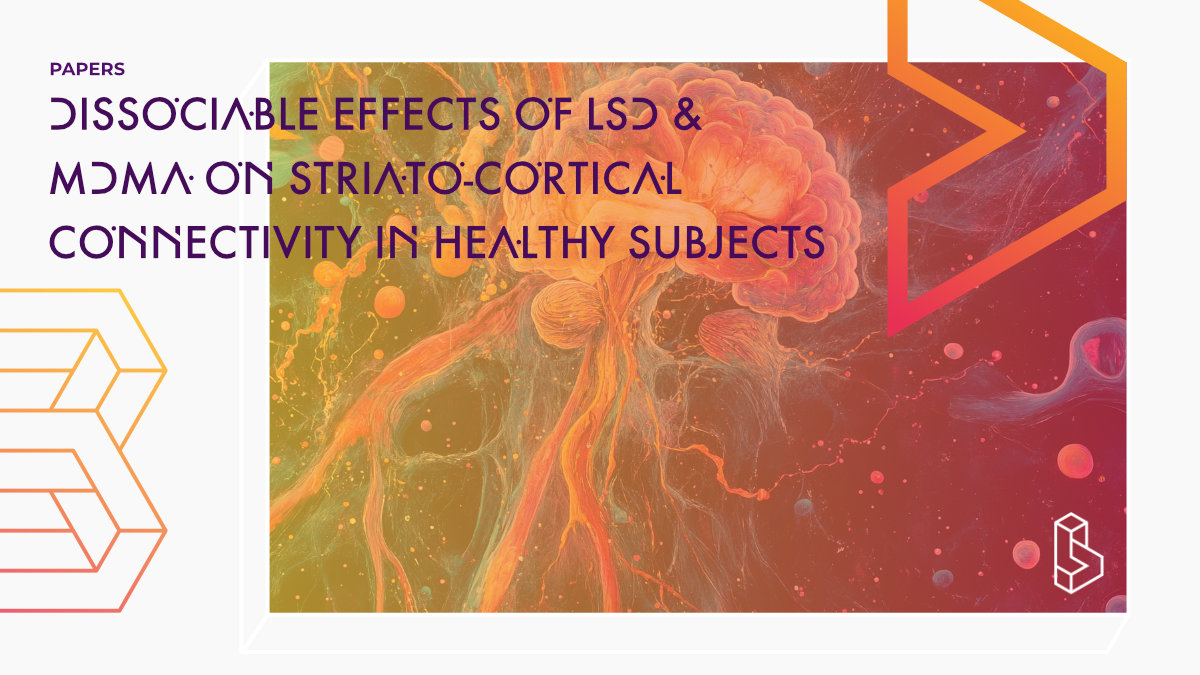This pre-print neuroimaging study (n=38) investigates the effects of MDMA and LSD on striatal connectivity (brain area, movement, and reward systems) using resting-state fMRI. The study finds that while neither drug significantly altered within-network connectivity of the striatum, both substances caused significant changes in connectivity with other brain regions, such as MDMA reducing connectivity between the limbic striatum and the amygdala and LSD increasing connectivity between the associative striatum and the frontal, sensorimotor, and visual cortices.
Abstract of Dissociable effects of LSD and MDMA on striato-cortical connectivity in healthy subjects
“Introduction Lysergic acid diethylamide (LSD) and 3,4-Methylenedioxymethamphetamine (MDMA) are widely used psychoactive drugs and their potential use in psychiatric medicine is currently generating interest. The mechanism by which these drugs may assist recovery in addiction, mood disorders and post-traumatic stress disorder (PTSD) is still not well understood. Most investigations of the effects of these drugs on brain activity have focussed on cortical resting-state networks, however the striatum is a key reward and motivation hub of the brain and aberrant striatal processing may be part of the pathophysiology of these disorders. Consequently, we investigated striatal connectivity following acute MDMA and LSD administration.
Method Resting-state fMRI (rs-fMRI) data were acquired, and seed-voxel functional connectivity analyses were used with the striatum subdivided into three seed regions: the associative, limbic, and sensorimotor striatum. Within-network connectivity was measured using group mean network maps and whole-brain connectivity (seed-to-voxel) was also examined.
Results Neither MDMA nor LSD significantly changed within-network connectivity of any of the three striatal seed regions. However, striatal connectivity with other brain regions was significantly altered with both MDMA and LSD. Most notably, MDMA reduced connectivity between the limbic striatum and the amygdala, while LSD increased connectivity between the associative striatum and the frontal, sensorimotor, and visual cortices.
Conclusion Changes in connectivity were mostly observed outside the standard striatal networks, consistent with previous findings that psychedelics reduce network modularity or between-network segregation and increase connectivity across standard networks.“
Authors: Natalie Ertl, Imran Ashraf, Lisa Azizi, Leor Roseman, David Erritzoe, David J. Nutt, Robin L. Carhart-Harris & Matthew B. Wall
Summary of Dissociable effects of LSD and MDMA on striato-cortical connectivity in healthy subjects
In recent years, psychedelics such as LSD, psilocybin, DMT, and MDMA have been increasingly studied for their therapeutic potential, particularly in treating psychiatric disorders. While these substances have a long history of medicinal use, their legal status and association with recreational use have historically hindered research. However, growing interest is fostering renewed exploration into their potential benefits in modern psychiatry.
Psychedelics, especially LSD, act as agonists at serotonin 5-HT2A receptors, leading to altered perceptions, cognition, and mood. LSD, known for its long-lasting effects, has been explored for its potential to treat disorders like alcohol addiction and depression. While less studied today, recent research has shown promise in treating anxiety and other mental health conditions. Neuroimaging studies have demonstrated increased blood flow and functional connectivity in the brain, particularly in the visual cortex, correlating with the vivid visual experiences reported by users. Other psychedelics, such as psilocybin and DMT, similarly disrupt cortical brain networks and increase global functional connectivity.
MDMA, an entactogen rather than a classic psychedelic, has gained attention for its emotional and social processing benefits. It acts as a monoamine releaser, particularly impacting serotonin, and has been explored for therapeutic uses in trauma therapy. Neuroimaging studies on MDMA suggest it alters brain activation in areas related to emotional processing, such as the amygdala and hippocampus.
The authors of this study focus on the striatum, a brain region involved in motivation, emotion, and decision-making, which is implicated in disorders such as addiction and PTSD. By investigating how MDMA and LSD affect striatal connectivity, they aim to gain deeper insights into their therapeutic potential.
Methods
Find this paper
Dissociable effects of LSD and MDMA on striato-cortical connectivity in healthy subjects
https://doi.org/10.1101/2025.02.07.637042
Open Access | Google Scholar | Backup | 🕊
Cite this paper (APA)
Ertl, N., Ashraf, I., Azizi, L., Roseman, L., Erritzoe, D., Nutt, D., ... & Wall, M. B. (2025). Dissociable effects of LSD and MDMA on striato-cortical connectivity in healthy subjects. bioRxiv, 2025-02.
Study details
Compounds studied
MDMA
LSD
Placebo
Topics studied
Healthy Subjects
Neuroscience
Study characteristics
Original Re-analysis
Placebo-Controlled
Double-Blind
Re-analysis
Bio/Neuro
Participants
38
Humans
Linked Research Papers
Notable research papers that build on or are influenced by this paper
The effects of acutely administered 3, 4-methylenedioxymethamphetamine on spontaneous brain function in healthy volunteers measured with arterial spin labeling and blood oxygen level–dependent resting state functional connectivityThis double-blind, placebo-controlled, balanced-order, within-subjects study (n=25) investigated how the subjective effects of MDMA are related to its neural effects .fMRI scans during MDMA use showed changes in cerebral blood flow in the right medial temporal lobe, thalamus, inferior visual cortex, somatosensory cortex, right amygdala and hippocampus, as well as decreased resting-state functional connectivity (RSFC) between midline cortical regions, the medial prefrontal cortex, and the medial temporal lobe, and increased RSFC between the amygdala and hippocampus.
Neural correlates of the LSD experience revealed by multimodal neuroimaging
Using three different neuroimaging techniques (ASL, BOLD, MEG), this single-blind, placebo-controlled study highlighted the neurological underpinnings of the LSD/psychedelic (75μg) experience.

